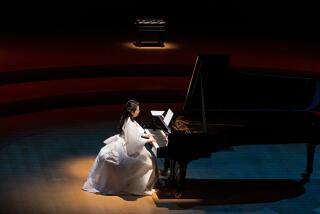Review: Caravaggio is boldly painted with music at LACMA
Caravaggio is a great subject for music. There are fascinating parallels between the way the artist helped usher in modern painting at the turn of the 17th century and the way his Italian contemporaries Monteverdi and Gesualdo laid the foundations for modern music.
In the last few years, Caravaggio, who happened to be a flamboyantly unstable character ever in trouble with the authorities, has also caught the imagination of today’s musicians. He’s been a subject for opera and ballet. An exhibition of the painter’s works six years ago inspired Jordi Savall, the Spanish early music specialist, to try his hand at improvisation on a brilliant recording called “Lachrimae Caravaggio.” An intriguingly sophisticated French experimental electronic pop band calls itself Caravaggio.
All of this — along with the fact that several of Caravaggio’s canvases provide a valuable look at musical society in his day — gave the Los Angeles County Museum of Art plenty to work with in putting together a program connected to its exhibition “Bodies and Shadows: Caravaggio and His Legacy.”
The show closes Sunday and the museum’s Art and Music series was just under the wire with a program Wednesday that included early music played in the Caravaggio galleries and the U.S. premiere of an Italian ballet. “Caravaggio,” choreographed by Matteo Levaggi, was performed by L.A. Contemporary Dance Company in the Bing Theater.
But Giovanni Sollima’s score to the ballet proved the real Caravaggio revelation. A cellist and composer from Palermo, Italy, he melds an original blend of early music, Minimalism, electronics, jazz, pop and world music. Coincidentally, the Chicago Symphony announced Wednesday that it has commissioned a double cello concerto from Sollima that he and Yo-Yo Ma will premiere with the orchestra under Riccardo Muti next season.
Sollima’s ballet score takes its inspiration from Caravaggio’s music paintings. The composer had a small violin, or violino, constructed to match the ones that Caravaggio reproduced. Sollima also played around with the musical fragments that can be seen on the scores in the canvases. The exhibition, however, isn’t very helpful in this regard. It includes none of Caravaggio’s music paintings, although it does show several with musical subjects by his followers.
LACMA was not eager to spring for the expense of bringing Sollima to L.A., so his score was not performed live. The Italian Cultural Institute, however, did make it possible for Levaggi to work with the dancers for 10 days in L.A.
There was, at least, live music in the galleries. Three local early music specialists — viola da gambist Denise Briesé, violinist Gregory Maldonado and lutenist Jason Yoshida — played short solo sets. They sometimes tended toward music from the high Baroque, later than Caravaggio’s time. The audience milled. It was amusing to muse on how times have changed, watching the eloquent and serious Yoshida seated under the lusty lutenist in Dirck van Baburen’s “The Procuress” and the roguish one in Theodoor Rombourts’ “A Lute Player.”
PHOTOS: Arts & culture by The Times
Though abstract, Levaggi’s 2004 ballet includes similarly robust and overtly expressive personalities. The most obvious Caravaggio connection, however, is in the severe lighting, which creates harsh shadows reminiscent of the uses of shadows and extremes of dark and light in the paintings. The seven dancers engage passionately and sometimes violently, also appropriate for an artist known for his belligerence.
The choreographic language itself, of extended limbs and confrontational attitude, rarely surprised. Still, the dancers (Michael Crotty, Zsolt Bank, Christian Beasly, Andrew Pearson, Drea Sobke, Kim Thompson and Diana Vaden) were consistently impressive. Mastering a 40-minute, ever-changing dance with a mere 10 days working with the choreographer is a major achievement.
Sollima’s score is mostly for cello and electronics. At times it plays off pieces by the 16th century Flemish composer Jacques Arcadelt — a score of his is in Caravaggio’s famous “The Lute Player.” But Sollima goes far afield with breathtaking imagination and performs with startling virtuosity.
He sweeps up Arcadelt into the swooping sounds of Chinese string instruments. He settles in Philip Glass-like and Michael Nyman-like repetitions, but he’s too restless to stay there for long.
Sometimes the improvisational bug hits him, and he wanders into strangely uncharted territories. He can get into a party mood turning his cello into a drum machine. He is irresistible when he gets deliciously moody but never sentimental. He also has a harshly in-your-face side.
It was a mistake not to have brought Sollima to town. LACMA’s reputation still suffers from having disposed of the Monday Evening Concerts a few years ago, and this could have been a coup.
But things are also looking up. Mitch Glickman, the museum’s director of music programs, is getting adept at working around his provincial mandate to relate this series to current exhibitions. He’s managed this spring to find a way to schedule an appearance by Steve Reich and also by New York’s excellent International Contemporary Ensemble.
MORE
INTERACTIVE: Christopher Hawthorne’s On the Boulevards
VOTE: What’s the best version of ‘O Holy Night’?
PHOTOS: Arts and culture in pictures
More to Read
The biggest entertainment stories
Get our big stories about Hollywood, film, television, music, arts, culture and more right in your inbox as soon as they publish.
You may occasionally receive promotional content from the Los Angeles Times.











